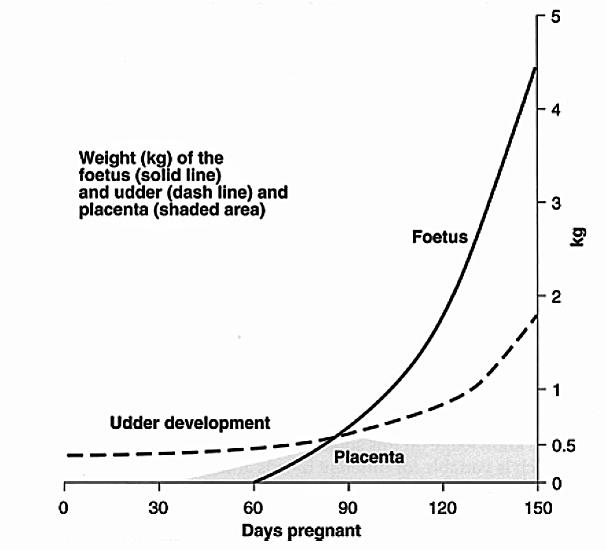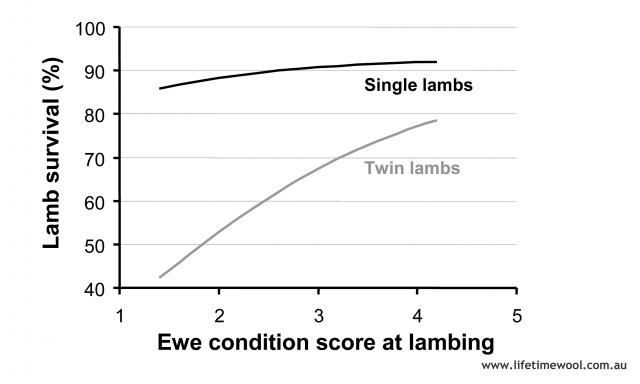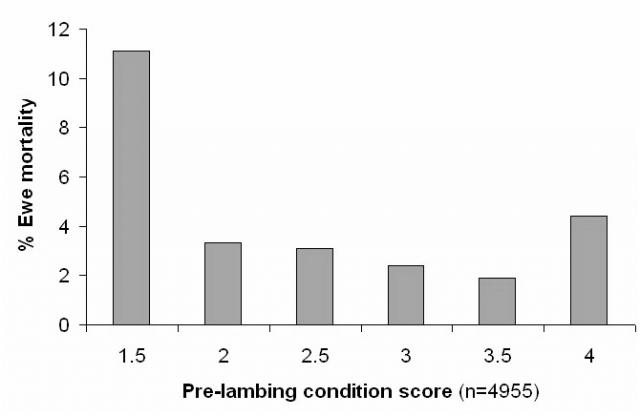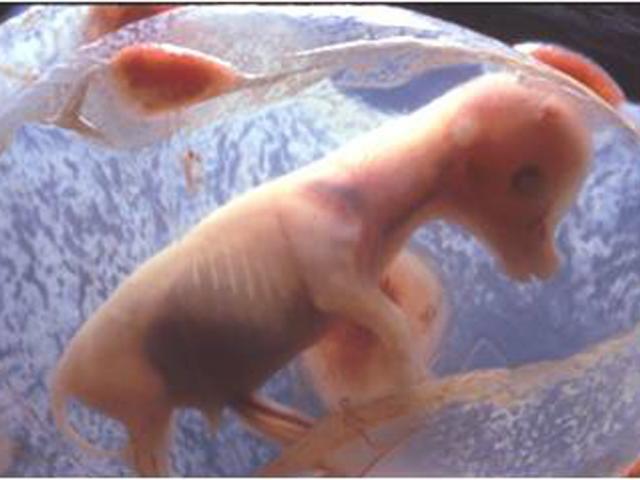Introduction
There are key factors to consider during pregnancy which affect the chances of successful lambing:
- ewe nutrition – at all stages of the pregnancy
- litter size – pregnancy scanning provides essential information to better manage the ewe flock
- vaccination and worm control.
Pregnancy is generally 150 days (five months). The majority of foetal growth occurs in the final 60 days; however, setting up effective nutrient transfer from the ewe to the foetus occurs with udder and placental development in the first trimester of pregnancy. Most of the wool follicle development occurs in the second and third trimesters and can be significantly affected by nutrition.

Nutrition during pregnancy
The nutrition of the ewe during pregnancy affects the liveweight and the wool production of the progeny over its lifetime. The ewe’s ability to survive and provide for the lamb over the difficult lambing period is also greatly affected by nutrition, and the level of nutrition will also affect her wool quality and quantity.
The impact of nutrition on placental growth
Poor nutrition throughout pregnancy can affect lamb growth and development by restricting the growth of the placenta (the channel that carries all nutrients to the developing foetus) and foetus.
The placenta and foetus are most susceptible to restrictions in the nutrition of the ewe during the periods when their growth is most rapid. For the first 50 days of pregnancy, growth of the placenta and foetus is minimal. In mid pregnancy, from day 50-100, growth of the placenta is rapid while foetal growth is minimal. In late pregnancy, from day 100-150, growth of the placenta has finished but growth of the foetus increases rapidly until birth.
Inadequate nutrition of the ewe in mid pregnancy can reduce the size and function of the placenta and nutrient restrictions during late pregnancy can reduce the growth rate and size of the foetus.
The development of wool follicles in Merino lambs
A lamb's future wool production is affected by ewe nutrition during pregnancy. Primary follicles (broad fibres) develop in the growing foetus from around day 60 of pregnancy and are completed by about 90 days after conception. Secondary follicles (fine fibres) develop from around day 90 to birth, with some follicle maturation occurring in the first month of the lamb's life. The density of follicles is determined prior to birth and will not change for the entire life of the animal.
Secondary follicles are the most important part of the wool-producing skin, having a direct influence on the density and fineness of the fleece. A reduction in nutrient supply to the developing foetus at the time of secondary follicle development (either because of poor nutrition or because there are multiple foetuses competing for nutrients) will lead to less secondary fibres, resulting in broader fibre diameter and lower fleece weight. These effects will persist throughout the lifetime of the progeny. There are linear relationships between changes in ewe condition and the amount and quality of wool produced by single and twin lambs.
The effects of changes in the condition score of the ewe during early or late pregnancy have a similar effect on hogget clean fleece weight and fibre diameter. The responses are linear:
- an increase of more than one condition score of the ewe results in an increase of 0.2 kilograms (kg) in clean fleece weight and reduction of 0.4 micron in fibre diameter in the progeny
- twin lambs produce 0.3kg less wool that is 0.3 micron broader than single lambs under the same nutritional scenario
- ewes that lose 0.5 condition score in early to mid-pregnancy increases the progeny fibre diameter by 0.2 micron in both single and twin lambs
- ewes that lose 0.5 condition score and then regain this condition by lambing produce progeny that will cut the same amount and fibre diameter of wool as those from ewes that maintain condition score throughout pregnancy.
The effects of early and late pregnancy nutrition on progeny wool production and quality are permanent throughout the animal's lifetime. They cannot be fully compensated for by improved nutrition after birth.
The impact of nutrition in pregnancy on lamb survival
Lamb birthweight is the single most important predictor of lamb survival. Poor ewe nutrition during pregnancy will reduce lamb birth weight by up to 0.5kg if significant condition is lost. These smaller lambs – particularly twins – are less likely to survive birth and will be smaller at weaning.
The first 48 hours of a lamb's life are critical. Around 70% of lamb mortality that occurs between birth and weaning occurs within this period. Lamb survival is related to lamb birth weight. Lamb birth weight is strongly related to the nutrition of the ewe during pregnancy, particularly late pregnancy and accounts for nearly 70% of the variation in survival.
The optimum birthweight for maximum lamb survival is between 4.5-5.5kg, but lambing environment and whether they are a single or twin, also affect the response.
Ewes in better condition at lambing have heavier lambs
Ewes in better condition at lambing produce bigger lambs. Optimal birthweights are from 4-6kg and a decrease in condition score of ewes during pregnancy can reduce lamb birthweight by 0.4-0.5kg in both single and twin lambs. Birthweights are most sensitive to changes in ewe condition in late pregnancy.
The impact of lamb birthweight on lamb survival
Lamb survival rate is mostly explained by differences in lamb birthweight but the lambing environment (such as bad weather, mothering) and whether they are born as a single or twin lamb affects the response.
Survival decreases sharply when lamb birthweight drops below 4.0kg. A 0.5kg decrease in birthweight from the average has less effect on the survival of single lambs than the survival of twin lambs (approximately 10-15% lower).

Lamb birthweight is determined by ewe nutrition both in early pregnancy (during placental development) and in the last third of pregnancy, which is a period of rapid foetal growth. Ewe nutrition during late pregnancy and lambing has a large effect on lamb survival through its influence on lamb birthweight.

Single bearing ewes should be in condition score 2.8 or more, and twin bearing ewes should be at least in condition score 3 by lambing to optimise lamb survival, especially in an environment susceptible to poor lambing conditions.
Poor ewe nutrition and low condition at lambing also has detrimental effects on maternal behaviour and lamb behaviour that contribute to increased mortality. Ideally the ewe and lamb should remain at the birth site for at least six hours.
| State | Condition score at lambing | Survival of singles (%) | Survival of twins (%) |
|---|---|---|---|
| Western Australia | 2.4 | 81 | 58 |
| Western Australia | 3.5 | 92 | 82 |
| Victoria | 2.2 | 74 | 38 |
| Victoria | 3.1 | 86 | 56 |
Tips:
- Scan for pregnancy – especially litter size so twinning ewes can be separately managed.
- Ensure ewes achieve the condition score target prior to lambing – condition score 3 gives good survival and production.
- Ewes need to be condition score 3 by lambing for singles and 3.3 for twins.
- Ewes need more feed when they are pregnant especially in the last 2 months - they need to reach good condition at the time of lambing to have a good size lamb and to have energy reserves for birth.
The impact of nutrition on ewe mortality
Ewe condition score at lambing can be important in managing ewe mortality, especially when weather conditions are poor. Mortality occurs mainly when condition score is less than 2 during late pregnancy. Twin bearing ewes are more at risk during late pregnancy and lambing. Single bearing ewes may have increased risk of dystocia if they are too heavy coming into lambing.

Tips:
- Twinners should be in condition score 3.3 by lambing and on good pasture to allow unrestricted intake to limit pregnancy toxaemia.
- Single ewes should be in condition score 2.8+ by lambing and should be less than condition score 4 to limit dystocia.
- Where poor weather is likely over lambing, shelter must be provided and effective predator control is important.
- Older ewes (full mouth and older) should have higher feed on offer at lambing to ensure adequate intake.
Management of lambing ewes
Your twinning ewes are the priority group of sheep on the farm. In most years they will make up at least 20% of your flock and be carrying nearly half of all potential lambs for that season.
Pregnancy scanning is a very useful tool in managing twinning ewes as they can be identified prior to lambing with time to provide closer monitoring and better nutrition. Draft off twinning ewes and run separately, or if paddock space doesn’t allow this, separate ewes in condition score less than 2.5 at day 90 of pregnancy and manage separately to increase condition score.
The ewe has an increasing feed demand, especially those bearing twins, in the last six weeks before birth. For example, a single bearing ewe of medium frame size requires 10 megajoules (MJ) of energy per day at day 100 of pregnancy, increasing to 13MJ of energy by lambing, and a twinning ewe requires 11.5MJ by day 100 and 16MJ by lambing.
Ewes that are pregnant while green feed is available need at least 700-1000kg dry matter per hectare (DM/ha) feed on offer (FOO) during late pregnancy with at least 1200kg DM/ha for twinning ewes. Information and photos of key FOO levels and pastures growth rates are available under 'links' in the side menu.
Ewes that are early lambers or lambing onto dry feed will require good quality supplementary feed with at least 12% protein and 10MJ of energy per kilogram. Learn more about supplementary feeding with our calculator.
It is important, at any condition score, that ewes either maintain or increase condition in the last third of pregnancy.
Think ahead so that you can prepare lambing paddocks and allocate the best paddocks to your priority mob. Consider controlling predation, providing shelter, and ensuring FOO will be near the target amount for the ewes by lambing.
| Ewes at lambing | Condition score target | Pasture target (kg DM/ha green FOO) |
|---|---|---|
| Single ewes | 3.0 | 1500 |
| Twinning ewes | 3.0+ | 1800+ |
Any ewes in less than condition score 2 at any time should be removed from the mob and managed separately.
Pregnancy scanning
Pregnancy scanning is a useful tool to help better manage ewe flocks. The two main reasons to scan are to identify twin-bearing and barren (dry) ewes. The costs and benefits of pregnancy scanning depend on the proportions of dry, single and twin ewes. As the reproductive rate increases (total number of foetuses/total number of ewes), the benefit of scanning for multiples increases, compared to the benefit of scanning for just wet/dry. Once above 90% scanning (90 foetuses per 100 ewes joined), the value of scanning for multiples becomes higher than the benefit for scanning on wet/dry alone.
The information can be used to separate mobs into single and twin lambing flocks and better allocate feed according to nutritional requirements. Twin-bearing ewes need to be 0.3 of a condition score better at lambing than single-bearing ewes to maximise lamb birthweight, lamb survival and ewe survival. This means higher feeding rates (unless they are on better pastures than single-bearing ewes). Separating into pregnancy classes allows such preferential feeding to occur. It also allows the number of ewes in twinning mobs to be managed.
Managing the dry ewes can also add value to the ewe flock as they can either be sold, or run as a dry wether flock with maintenance feeding only. This will save substantially on feed as a dry sheep will eat as much as a pregnant ewe for no profitable gain, and will compete for feed when feed is limiting.
Pregnancy scanning is done by ultrasound and needs a skilled operator for accuracy. It should be completed 42–62 days after the rams come out, assuming a five-week mating. The cost of scanning is readily recouped due to the feed saved through better allocation of feed.
Scanning for multiple-bearing ewes
If multiple-bearing ewes are identified the following points should be taken into account:
- Better condition in late pregnancy leads to better survival of lambs.
- Identifying and separating multiple-bearing ewes minimises over-feeding of single-bearing ewes and potential birthing problems with dystocia.
- Multiple-bearing ewes do need more feed but this can potentially come from reducing the feeding rate of single-bearing ewes.
- Consider not scanning for twins if the twinning rate is less than 15%.
- Best results for preferential feeding are seen in a hard year.
- Preferential feeding must be matched with good husbandry — this is especially important if ewes have been managed for high conception rates.
Pre-lambing vaccination and worm control
An annual booster vaccination is recommended for all ewes pre-lambing as there is a level of protection provided to newborn lambs via colostrum of the mother. This will protect the ewe and lamb from clostridial diseases.
Worm control is also important in the lambing ewe, and starts with an effective autumn drench to ewes to reduce the level of pasture contamination with worm eggs during winter. The potential worm problem in the lambs to be born is governed by the level of pasture contamination with worm eggs, and this is largely determined by the effectiveness of the autumn drenching program in the ewes. Thus, it is essential to give an effective (100%) drench at the critical time. For ewes this means drenching in autumn — from mid-March to mid-April.
Additional pre-lambing drenches may be required in some years depending on the season. This is especially likely in ewes lambing later than mid-June.
Monitor faecal worm egg counts and if results are greater than 200 eggs per gram then a drench may be required.


